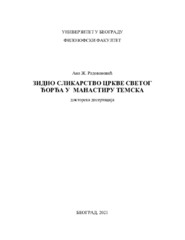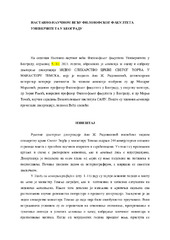Приказ основних података о дисертацији
Зидно сликарство Цркве Светог Ђорђа у Манастиру Темска
Fresco painting in Temska Monastery's Church of St. George
| dc.contributor.advisor | Marković, Miodrag | |
| dc.contributor.other | Marković, Miodrag | |
| dc.contributor.other | Rakić, Zoran | |
| dc.contributor.other | Tomić-Đurić, Marka | |
| dc.creator | Radovanović, Ana | |
| dc.date.accessioned | 2022-12-03T08:31:45Z | |
| dc.date.available | 2022-12-03T08:31:45Z | |
| dc.date.issued | 2022-09-05 | |
| dc.identifier.uri | https://eteze.bg.ac.rs/application/showtheses?thesesId=8828 | |
| dc.identifier.uri | https://fedorabg.bg.ac.rs/fedora/get/o:27011/bdef:Content/download | |
| dc.identifier.uri | https://plus.cobiss.net/cobiss/sr/sr/bib/68954121 | |
| dc.identifier.uri | https://nardus.mpn.gov.rs/handle/123456789/20913 | |
| dc.description.abstract | Предмет проучавања докторске дисертације је зидно сликарство цркве Светог Ђорђа у манастиру Темска код Пирота. Рад је, поред програмско-иконографских особености живописа, посвећен и проучавању ликовних и стилских особености овог фреско ансамбла и идејним основама његовог тематског програма. Манастир Темска, са својом бурном и богатом историјом у време вековног турског ропства, постао је центар духовног и националног живота области горњег Понишавља. Захваљујући обиљу сачуваног епиграфског материјала у могућности смо да реконструишемо најважније догађаје из историје и живота манастира. Велики број натписа и записа исписаних или угребаних у цркви, на надгробним споменицима или црквеним књигама омогућиo је податке о времену живописања храма, тачној години подизања припрате, игуманима и ктиторима, као и о бројним везама које је манастир одржавао са околним храмовима. Ипак, натписи смештени унутар цркве нису нам у потпуности дали одговоре на питања о времену градње наоса и пореклу сликара обе фазе живописа. Натпис о живописању храма налази се на западном зиду наоса, из кога се сазнаје да је завршено 1576. године, трудом игумана Захарија, што је послужило као основ за претпоставку да је црква грађена непосредно пре осликавања, највероватније 1575. године. Име ктитора није забележено унутар цркве, као што не постоји ни ктиторска композиција, али се на сачуваном натпису у олтару, јужно од проскомидије, помињу игуман Захарија и ктитори, највероватније сеоски приложници из овога краја. Натписи на источном и јужном зиду припрате омогућили су прецизније податке о њеном зидању и живописању 1654. године, за време игумана Симеона. Како се из натписа закључује да су и наос и припрата живописани за релативно кратко време, у раду је изнета претпоставка да је у свакој од ове две сликарске групе засигурно радио главни зограф са барем једним мајстором помоћником, односно, да су радила најмање два мајстора у свакој целини. Истраживања у раду обухватила су и детаљну палеографску анализу слова из натписа и сигнатура на фрескама, која је показала да, када је реч о старијем сликарству наоса, постоји један рукопис, који је по свој прилици припадао главном зографу, и то српског порекла. Када је реч о пореклу сликара млађег сликарства припрате, истраживање је показало да би они могли бити чланови неких од путујућих тајфи које су пристигле са Југа, највероватније из северозападне Грчке или данашње јужне Албаније. Будући да у досадашњим истраживањима зидно сликарство цркве Светог Ђорђа никада није темељно обрађено, до краја идентификовано и на адекватан начин протумачено, циљ истраживања био је сачињавање свеобухватног прегледа тематског програма фресака и анализа свих аспеката програмске структуре живописа. У раду је начињена идентификација одређеног броја појединачних фигура, појединачних сцена и сцена које су улазиле у састав циклуса, који су у претходној литератури или остали непримећени или нетачно протумачени. Иако је програмска, иконографска и стилска анализа фресака показала релативно уобичајен садржај типичан за храм ове величине, у оквиру сликане декорације уочена су и нека решења која немају паралеле у сликарству византијске и поствизантијске епохе. Извођењем аналогија са временски и територијално блиским и удаљеним сликаним ансамблима византијског света дошло се до закључка да су поједине сцене из циклуса патрона храма, као и поједина спајања сцена у оквиру једне фреске, али и појединачни иконографски детаљи у сценама, јављају само у Темској. Посебну вредност у живопису цркве Светог Ђорђа у Темској имају упливи локално наглашаваних култова. Домаће традиције посебно су утицале на стварање мотива у иконографији Страшног суда, где нису понављане раније утврђене шеме, већ су примери грешника узети из блиске околине и тиме портретисани животи обичног српског сељака. | sr |
| dc.description.abstract | The subject of the doctoral dissertation is wall painting in the Church of St. George in the Temska Monastery, near Pirot. Besides the special program and iconographic characteristics of the frescoes, the work is also devoted to studying the visual and stylistic features of this fresco ensemble and the conceptual foundations of its thematic program. The Temska Monastery, with its turbulent and rich history at the time of multicentennial Turkish occupation, became a center of the spiritual and national life of the upper Ponišavlje area. Thanks to a wealth of preserved epigraphic material, we are able to reconstruct the most important events from the monastery’s history and life. The numerous writings and inscriptions written or scratched into the church’s headstones or church books have provided data on the time of fresco painting in the church, the exact year the narthex was built, the hegoumenoi and the ktetors, as well as on the many ties the monastery maintained with nearby churches. Nonetheless, the writings inside the church have not fully answered our questions about the time of building of the nave and about the origin of the painters of both phases of fresco painting. The inscription concerning the fresco painting of the church is located on the western wall of the nave, from which we learn that it was completed in 1576, through the efforts of hegoumenos Zachary, which served as grounds for the assumption that the church was built just before the fresco painting, most likely in 1575. The ktetor’s name is not documented in the church, just like there is no ktetorial composition, but hegoumenos Zachary and the ktetors, most probably village contributors from this area, are mentioned in the preserved inscription at the altar, south of the proskomedia. The inscriptions on the eastern and southern wall of the narthex provided more specific data on the building and fresco painting of the church in 1654, during the term of hegoumenos Simeon. Since the inscriptions lead to the conclusion that the frescoes in both the nave and the narthex were painted in a relatively short time, the paper presents the assumption that a main zograf and at least one assistant master must have worked on both of these groups of paintings, i.e., that at least two masters must have worked on each of the fresco units. The research in the paper also included a detailed paleographic analysis of the letters in the inscriptions and signatures on the frescoes, which showed that, where the older painting of the nave is concerned, there is one handwriting which likely belonged to the main zograf, of Serbian origin. As for the origin of the painter of the younger painting in the narthex, the research showed that they could have been members of some of the traveling tayfas (zograf workshops) which had come from the south, most likely from northwestern Greece or present-day southern Albania. Given that in research conducted so far the wall painting of the church of St. George has never been thoroughly processed, fully identified and adequately interpreted, the aim of the research was to put together a comprehensive review of the thematic program of the frescoes and an analysis of all aspects of the program structure of the frescoes. The paper identifies a number of individual figures, individual scenes and scenes that were included in cycles, which had either been overlooked or incorrectly interpreted in previous literature. Even though the program, iconographic and stylistic analysis of the frescoes showed relatively usual content typical of a church of this size, some solutions without parallels in the painting of the Byzantine and post-Byzantine epochs were also detected among the painted decorations. The drawing of analogies with temporally and territorially close and distant painted ensembles of the Byzantine world led to the conclusion that certain scenes from the cycle of the church patron, as well as certain amalgamations of scenes within a single fresco, but also individual iconographic details, appear only in Temska. The influence of locally highlighted cults poses a special value in the fresco painting of the Church of St. George in Temska. Domestic traditions particularly affected the creation of motifs in the iconography of the Last Judgment, where previously defined patterns were not repeated, but rather the examples of sinners were taken from the direct vicinity and thereby portrayed the lives of ordinary Serbian peasants. | en |
| dc.format | application/pdf | |
| dc.language | sr | |
| dc.publisher | Универзитет у Београду, Филозофски факултет | sr |
| dc.rights | openAccess | en |
| dc.source | Универзитет у Београду | sr |
| dc.subject | зидно сликарство | sr |
| dc.subject | wall painting | en |
| dc.subject | Temska Monastery | en |
| dc.subject | iconography | en |
| dc.subject | epigraphic material | en |
| dc.subject | post-Byzantine period | en |
| dc.subject | Манастир Темска | sr |
| dc.subject | иконографија | sr |
| dc.subject | епиграфски материјал | sr |
| dc.subject | поствизантијски период | sr |
| dc.title | Зидно сликарство Цркве Светог Ђорђа у Манастиру Темска | sr |
| dc.title.alternative | Fresco painting in Temska Monastery's Church of St. George | en |
| dc.type | doctoralThesis | |
| dc.rights.license | ARR | |
| dc.identifier.fulltext | http://nardus.mpn.gov.rs/bitstream/id/147475/Disertacija_12837.pdf | |
| dc.identifier.fulltext | http://nardus.mpn.gov.rs/bitstream/id/147476/Referat_Redovanovic.pdf | |
| dc.identifier.rcub | https://hdl.handle.net/21.15107/rcub_nardus_20913 |



